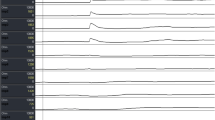Abstract
Background
Elderly people experience a heavy physical burden due to deteriorated respiratory function owing to prolonged sitting defecation posture due to constipation. In recent years, to reduce the physical burden of defecation, arm support handrails, which support the arms in a forward-leaning posture, have become more widely available; however, their impact on breathing comfort has not yet been verified. This study’s purpose was to compare the respiratory function of elderly people in traditional defecation postures and the arm-supported, forward-leaning position using the handrail, and thus verify whether the supported position has a positive effect.
Methods
The trunk leaning angle, respiratory function, thoracic range of motion, and subjective comfort of 57 healthy elderly people were measured and compared in each of the three sitting defecation postures: upright, forward-leaning, and arm-supported forward-leaning.
Results
The arm-supported, forward-leaning position involves a trunk leaning angle of 61.84° ± 7.47°, and vital capacity of the respiratory function, thoracic range of motion (axillary region), and subjective comfort in this position are all shown to be significantly higher than those in the other postures.
Conclusion
The arm-supported, forward-leaning defecation posture provides a high degree of freedom in the abdomen due to proper forward-leaning, while the upper limb support improves the mobility of the upper thorax, thus ensuring high lung volume. In addition, the increased stability provides a comfortable feeling. Therefore, we conclude that the arm-supported, forward-leaning position is more effective for defecation than the general defecation position.

Similar content being viewed by others
References
Panigrahi MK, Kar SK, Singh SP, Ghoshal UC. Defecation frequency and stool form in a coastal eastern Indian population. J Neurogastroenterol Motil. 2013;19:374–80.
Levison H, Cherniack RM. Ventilatory cost of exercise in chronic obstructive pulmonary disease. J Appl Physiol. 1968;25:21–7.
Secker-Walker PH, Ho JE, Gill IS. Observations on regional ventilation and perfusion in kyphoscoliosis. Respiration. 1979;38:194–203.
Defecation postures -Wikipedia. https://en.wikipedia.org/wiki/Defecation_postures (Accessed 4 Apr 2020).
Takano S, Sands D. Influence of body posture on defecation: a prospective study of “The Thinker” position. Tech Coloproctol. 2016;20:117–21.
Zacharkow D. Posture: Sitting, Standing, Chair Design and Exercise. Illinois: Charles C Thomas Pub Ltd.; 1988. p. 12–64.
LaPier TK, Donovan C. Sitting and standing position affect pulmonary function in patients with COPD: a preliminary study. Cardiopulm Phys Ther J. 1999;10:8–13.
Ogino T, Mase K, Nozoe M, et al. Effects of arm bracing on expiratory flow limitation and lung volume in elderly COPD subjects. Respir Care. 2015;60:1282–7.
Izumizaki M, Satake M, Takahashi H, Sugawara K, Shioya T, Homma I. Effects of inspiratory muscle thixotropy on the 6-min walk distance in COPD. Respir Med. 2008;102:970–7.
Hinman MR. Comparison of thoracic kyphosis and postural stiffness in younger and older women. Spine J. 2004;4:413–7.
Vaughn DW, Brown EW. The influence of an in-home based therapeutic exercise program on thoracic kyphosis angles. J Back Musculoskelet Rehabil. 2007;20:155–65.
Miller MR, Hankinson J, Brusasco V, et al. tandardisation of spirometry. Eur Respir J. 2005;26:319–38.
American Thoracic Society/European Respiratory Society. ATS/ERS statement on respiratory muscle testing. Am J Respir Crit Care Med. 2002;166:518–624.
Ando T, Kawamura K, Fujitani J, et al. Biofeedback effect of thoracic excursion in chest expansion training. J Biomech Sci Eng. 2012;7:328–34.
Nishigaki Y, Mizuguchi H, Takeda E, et al. Development of new measurement system of thoracic excursion with biofeedback: reliability and validity. J Neuro Eng Rehabil. 2013;10:45.
Hjermstad MJ, Fayers PM, Haugen DF, et al. Studies comparing numerical rating scales, verbal rating scales, and visual analogue scales for assessment of pain intensity in adults. J Pain Symptom Manag. 2011;41:1073–93.
Craig AB. Effects of position on expiratory reserve volume of the lungs. J Appl Physiol. 1960;15:59–61.
Vellody VP, Nassery M, Druz WS, Sharp JT. Effect of body position change on thoracoabdominal motion. J Appl Physiol. 1978;45:581–9.
Sharp JT, Drutz WS, Moisan T, et al. Postural relief of dyspnea in severe chronic obstructive pulmonary disease. Am Rev Respir Dis. 1980;122:201–11.
Druz WS, Sharp JT. Electrical and mechanical activity of the diaphragm accompanying body position in severe chronic obstructive pulmpnary disease. Am Rev Respir Dis. 1982;125:275–80.
Thomson A, Skinner A, Piercy J. Tidy’s Physiotherapy. 12th ed. Boston: Butterworth Heinemann; 1991.
Prandi E, Couture J, Bellemare F. In normal subjects bracing impairs the function of the inspiratory muscles. Eur Respir J. 1999;13:1078–85.
Teramoto S, Suzuki M, Matsuse T, et al. Influence of kyphosis on the age-related decline in pulmonary function. Nippon Ronen Igakkai Zasshi. 1998;35:23–7.
Funding
This work was supported by JSPS KAKENHI Grant Number JP19K19879.
Author information
Authors and Affiliations
Corresponding author
Ethics declarations
Conflict of interest
DT, MN, EK, and KH declare that they have no conflict of interest.
Ethics statement
The study was performed conforming to the Helsinki declaration of 1975, as revised in 2000 and 2008 concerning human and animal rights, and the authors followed the policy concerning informed consent as shown on Springer.com.
Ethical approval
This study was approved by the International University of Health and Welfare Ethics Review Board.
Informed consent
Informed consent was obtained from all participants before the commencement of the study (approval number: 18-Ifh-025)
Disclaimer
The authors are solely responsible for the data and the contents of the paper. In no way, the Honorary Editor-in-Chief, Editorial Board Members, the Indian Society of Gastroenterology, or the printer/publishers are responsible for the results/findings and content of this article.
Additional information
Publisher’s note
Springer Nature remains neutral with regard to jurisdictional claims in published maps and institutional affiliations.
Supplementary Information
ESM 1
(DOCX 41 kb)
Rights and permissions
About this article
Cite this article
Tashiro, D., Nakahara, M., Kitajima, E. et al. Respiratory function and comfort levels in three different defecatory simulation postures in the elderly. Indian J Gastroenterol 40, 131–136 (2021). https://doi.org/10.1007/s12664-020-01093-0
Received:
Accepted:
Published:
Issue Date:
DOI: https://doi.org/10.1007/s12664-020-01093-0




